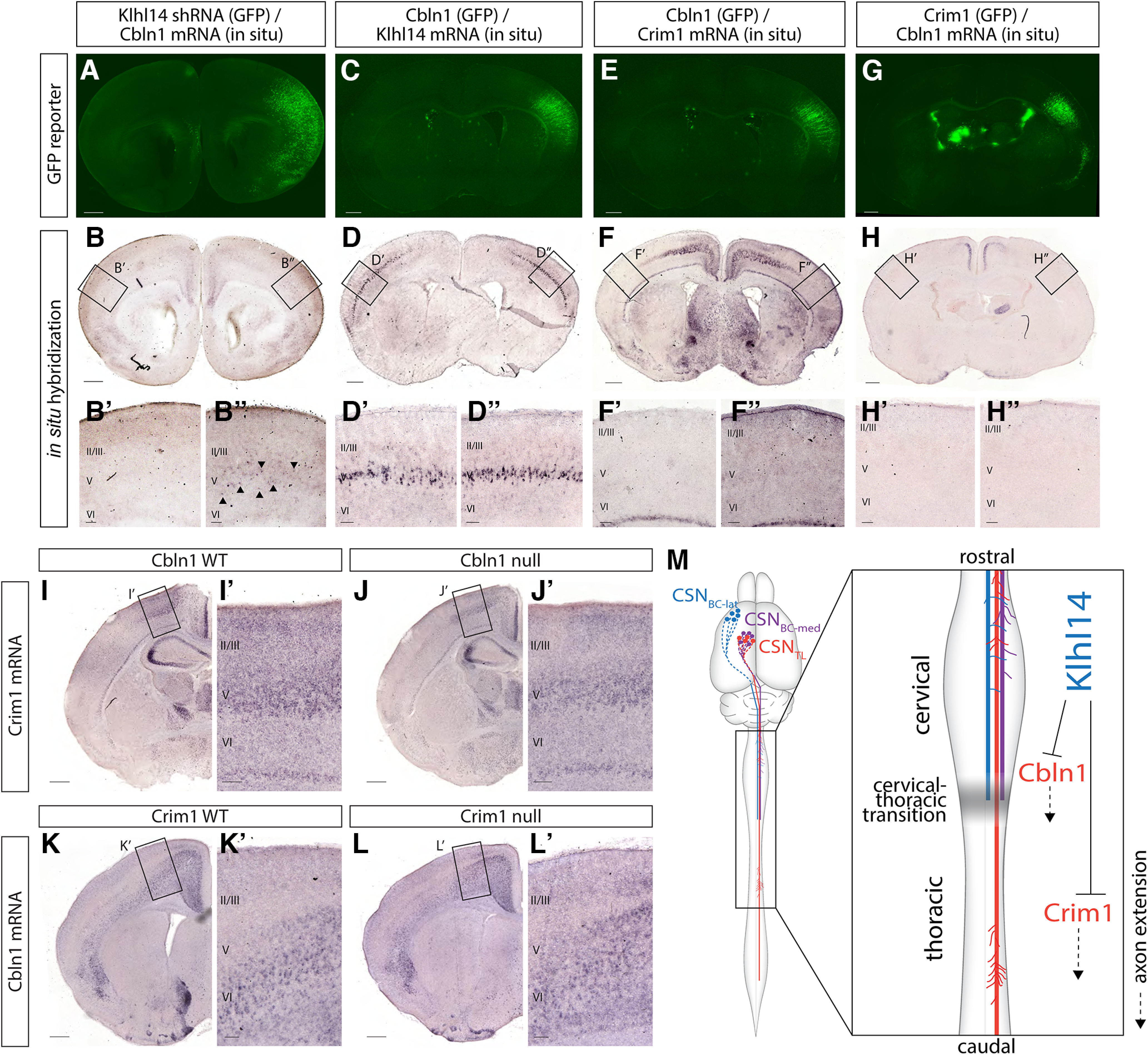Figure 10.

Cbln1 expression is regulated by Klhl14 but not by Crim1. A, B, Coronal section of a P4 brain that was electroporated in utero at E12.5 with Klhl14 shRNA. A, EGFP fluorescence (green) shows the site of electroporation in lateral cortex. B, In situ hybridization image of the same section in (A) shows Cbln1 expression. Cbln1 is normally restricted to medial cortex. However, Klhl14 knock-down by shRNA causes ectopic Cbln1 expression in lateral cortex (arrowheads in B”) in the electroporated cortical hemisphere (compare B” with contralateral B'). C, D, Coronal section of a P4 brain that was electroporated in utero at E12.5 with a plasmid containing Cbln1 and EGFP (Cbln1-EGFP). C, EGFP fluorescence (green) shows the site of electroporation in lateral cortex. D, In situ hybridization image of the same section in C showing Klhl14 expression in Cbln1-misexpressing CSNBC-lat remains unchanged, indicating that Klhl14 expression in lateral Layer V is unaffected by Cbln1 misexpression. E, F, Coronal section of a P4 brain that was electroporated in utero at E12.5 with Cbln1-EGFP. E, EGFP fluorescence (green) shows the site of electroporation in lateral cortex. F, In situ hybridization image of the same section in E showing that there is no ectopic Crim1 expression in Cbln1-misexpressing CSNBC-lat. G, H, Coronal section of a P4 brain that was electroporated in utero at E12.5 with Crim1-EGFP. Crim1 misexpression in CSNBC-lat can redirect axons toward caudal thoracic spinal segments (Sahni et al., 2021b). G, EGFP fluorescence (green) shows the site of electroporation in lateral cortex. H, In situ hybridization image of the same section in (G) showing that there is no ectopic Cbln1 expression in Crim1-misexpressing CSNBC-lat. I, J, Crim1 expression in medial Layer V does not differ between Cbln1 WT and Cbln1 null mice. K, L, Cbln1 expression in medial Layer V does not differ between Crim1 WT and Crim1 null mice. M, Summary schematic displaying molecular controls over CSN axon extension both at, and beyond, the transition between cervical and thoracic spinal segments. Together with the previous investigations identifying Crim1 and Klhl14 function (Sahni et al., 2021b), our data suggest a model whereby Cbln1 directs CSN axon extension from the cervical into the thoracic cord, whereas Crim1 directs those CSN axons that cross this transition zone to extend further toward caudal thoracic and lumbar spinal segments. This indicates that CSN segmental axon targeting toward thoracic and lumbar segments involves multiple, distinct molecular regulators acting at distinct spinal levels. Klhl14, which is specifically expressed in CSNBC-lat and restricts CSNBC-lat axon extension to the bulbar-cervical segments, represses the expression of both Cbln1 and Crim1 in CSNBC-lat. This indicates that Klhl14 represses a broad program of thoraco-lumbar directed axon extension in CSNBC-lat. This program, mediated by multiple independent molecular controls, would otherwise direct CSN axons past the cervical cord toward caudal thoracic and lumbar segments. Scale bars are 100 µm for insets and 500 µm for all other images.
